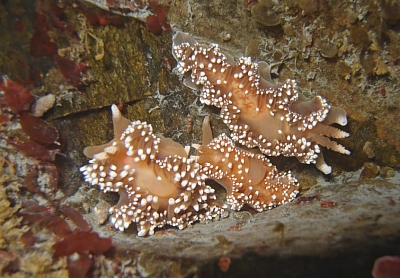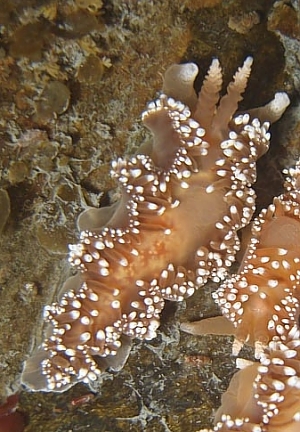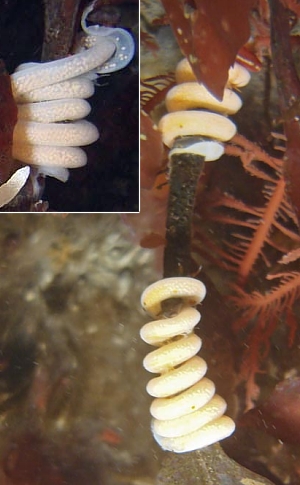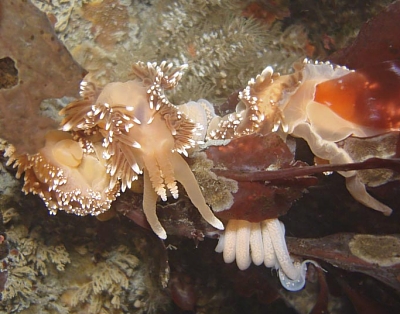Notaeolidia gigas from Antarctic waters
February 21, 2007
From: David Cothran

Hi Bill,
I made a dive today at Elephant Island, in the far eastern end of the South Shetlands. In a small area of the rocky wall I found six individuals of what appears to be a species of Notaeolidia, possibly N. schmekelae, though they differ in some respects from the few images I have seen. I first noticed an egg mass on a rhodophyte stalk (shown in the middle right photo - not very sharp but the best I could manage in 1 meter visibility and strong surge ...!): I then found the six animals about 3 meters higher. Three of them were in the group shown in the top photo and, adjacent to them, on another rhodophye, three more that were actively laying (lower photo). Any thoughts on the species ID?
Locality Details: Point Wild, Elephant Island, South Shetland Islands, Southern Ocean. 22 meters, Lengths: 6 -11cm. 19 February 2007. Rock wall. Photos: David Cothran
By the way, this is the site where Sir Ernest Shackelton's men waited for rescue while he made the historic journey to South Georgia in the James Caird.
Best regards
David
david@wandering-eye.com



Dear David,
I don't normally post messages immediately - although I wish I could - but I find the thought that we can look at these photos which you took only a few hours ago in Antarctic waters, a good enough reason to jump the queue. I guess if Shackleton had had the internet, he wouldn't have needed to risk his life sailing 1500 km in a 7 m open boat to get help for his stranded crew.
Now to your nudibranchs. The species of this genus are best identified by their internal anatomy, but I am pretty sure your animals are Notaeolidia gigas. Notaeolidia gigas and N. schmekelae are the two largest species, and can have two or three rows of cerata, which your animals seem to do. Of those two species, only N. gigas has been reported from the South Shetland islands and the waters off the Antarctic Peninsula, so I am tentatively sugesting this is N. gigas. It is possible however, that N. schmekelae has just not been found there at present.
The egg ribbons are very interesting. I can't recall seeing egg ribbons reported for any species of Notaeolidia, so this is a valuable find.
Best wishes,
Bill Rudman
Related messages
-
Notaeolidia gigas from King George Island, Antarctica
From: Bill Rudman, March 16, 2007 -
Re: Notaeolidia gigas? from McMurdo Sound
From: Bill Rudman, February 10, 1999
